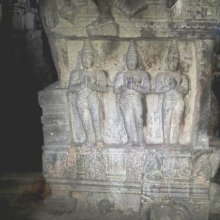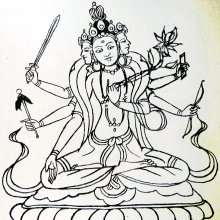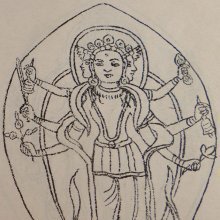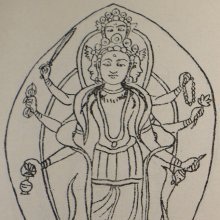Three: 1 definition
Introduction:
Three means something in Hinduism, Sanskrit. If you want to know the exact meaning, history, etymology or English translation of this term then check out the descriptions on this page. Add your comment or reference to a book if you want to contribute to this summary article.
Images (photo gallery)
(+601 more images available)
In Hinduism
Natyashastra (theatrics and dramaturgy)
Source: Shodhganga: Elements of Art and Architecture in the Trtiyakhanda of the Visnudharmottarapurana (natya)The number Three is associated with Tripatāka-hasta: one of the twenty-two Single-hand Gestures (in Indian Dramas) (known as asaṃyuktahastas), according to the Viṣṇudharmottarapurāṇa, an ancient Sanskrit text which (being encyclopedic in nature) deals with a variety of cultural topics such as arts, architecture, music, grammar and astronomy.—The word tripatāka itself identifies the importance of the number three. According to the Viṣṇudharmottarapurāṇa in tripatākahasta, three fingures should be straightened in a patākahasta where the ring finger is bent. Abhinavagupta also keeps his view point in the same way

Natyashastra (नाट्यशास्त्र, nāṭyaśāstra) refers to both the ancient Indian tradition (shastra) of performing arts, (natya—theatrics, drama, dance, music), as well as the name of a Sanskrit work dealing with these subjects. It also teaches the rules for composing Dramatic plays (nataka), construction and performance of Theater, and Poetic works (kavya).
See also (Relevant definitions)
Starts with (+62): Three Appendants, Three Aspirations, Three cities, Three Classifications, Three Delusions, Three Discriminations, Three Divine Messengers, Three Dogmas, Three Doors Of Deliverance, Three Energies, Three Evil Paths, Three Fold Training, Three Gems, Three Gifts, Three Good Paths, Three Great Secret Laws, Three Kinds of Aspiration, Three Kinds Of Craving, Three Kinds of Discrimination, Three kinds of Energy.
Ends with: Stri, Vivakastri.
Full-text (+16113): Triguna, Triphala, Tridanda, Tridha, Trailokya, Guna, Trivarga, Trika, Traya, Tri, Gunatraya, Trikala, Trishas, Trivali, Tridosha, Ratnatraya, Triratna, Traimasika, Tryambaka, Trayi.
Relevant text
Search found 517 books and stories containing Three; (plurals include: Threes). You can also click to the full overview containing English textual excerpts. Below are direct links for the most relevant articles:
A Heart Released (by Phra Ajaan Mun Bhuridatta Thera)
Rig Veda (translation and commentary) (by H. H. Wilson)
Chandogya Upanishad (Shankara Bhashya) (by Ganganatha Jha)
Section 2.21 (twenty-first khaṇḍa) (four texts) < [Chapter 2 - Second Adhyāya]
Section 2.10 (tenth khaṇḍa) (six texts) < [Chapter 2 - Second Adhyāya]
Section 6.3 (third khaṇḍa) (four texts) < [Chapter 6 - Sixth Adhyāya]
The Devi Bhagavata Purana (by Swami Vijñanananda)
Chapter 8 - On the Guṇas and their forms < [Book 3]
Chapter 23 - On the Tapta Kṛcchra vrata and others < [Book 11]
Bhakti-rasamrta-sindhu (by Śrīla Rūpa Gosvāmī)
Verse 2.1.178 < [Part 1 - Ecstatic Excitants (vibhāva)]
Verse 2.1.49 < [Part 1 - Ecstatic Excitants (vibhāva)]
Verse 4.4.4 < [Part 4 - Compassion (karuṇa-rasa)]
Philosophy of language in the Five Nikayas (by K.T.S. Sarao)
2.5(e). Aṅguttara Nikāya (Numerical Discourses of the Buddha) < [Chapter 1 - Introduction]
2. The Buddhist Pāli Tipiṭaka (Introduction) < [Chapter 1 - Introduction]
3. On Language (5): Levels of Language < [Chapter 2 - Concept of Philosophy of Language]
Related products
(+76 more products available)











